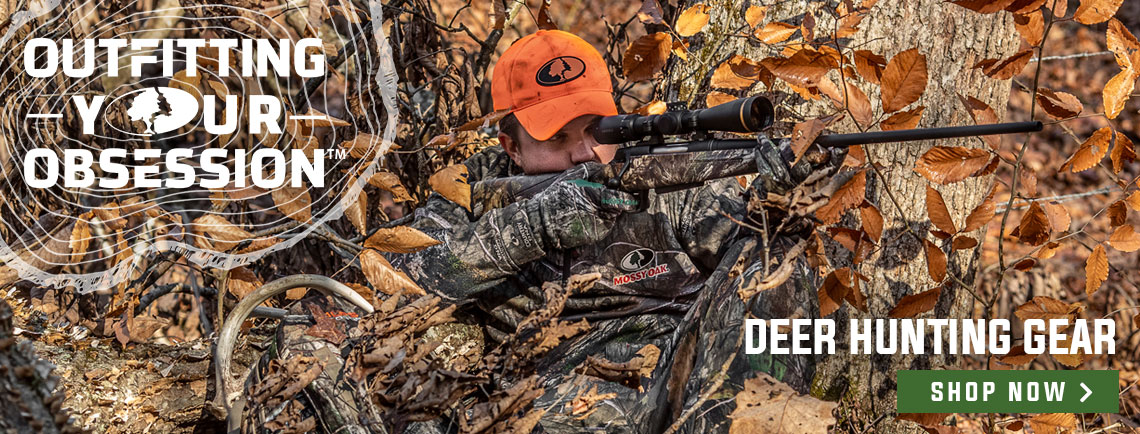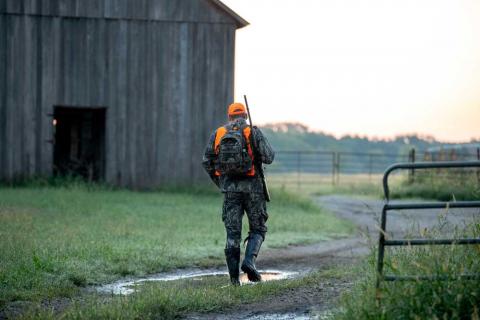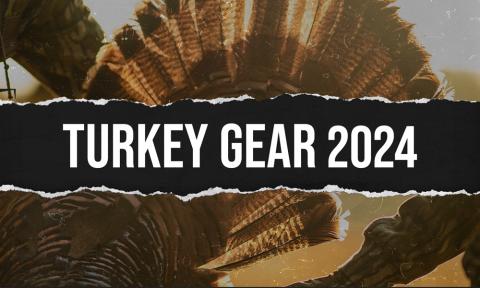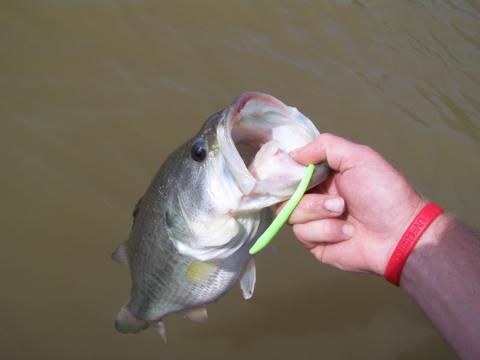by Bob Humphrey | Humphrey is a certified wildlife biologist who, in addition to studying deer, has hunted them across North American for over 40 years.
How Often Do Deer Move?
Before diving in to the effect moon phase has on deer movement, it's important to look at when deer move in general. A deer's mission is to go out and find food quickly. Deer go out for food twice a day, typically, so you know a deer will get up to move around their feeding schedule.
How does moon phase influence whitetail behavior?
Since we first learned to fashion stick and stone into tools, mankind has been on an insatiable quest to outwit the wary whitetail. We are forever searching for insight into what makes them tick and how different environmental factors might influence their daily routines, or if they even have routines. Among the more aggressive efforts has been the search for clues as to how the moon influences deer movement. But before we can begin such an epic quest, we need to be pointed in the right direction.
What is Moon Phase?
Flat earth fanatics aside, most of us are familiar with the facts about moon phase. Still, a little refresher course can’t hurt.
The moon rotates on its axis at the same rate it orbits the Earth. As a result, only one side of the moon is visible from Earth. However, the moon is illuminated by varying degrees of sunlight over the course of a month, depending on its position in orbit. This variation is broken down in four intermediate lunar phases, each spanning about 7.4 days.
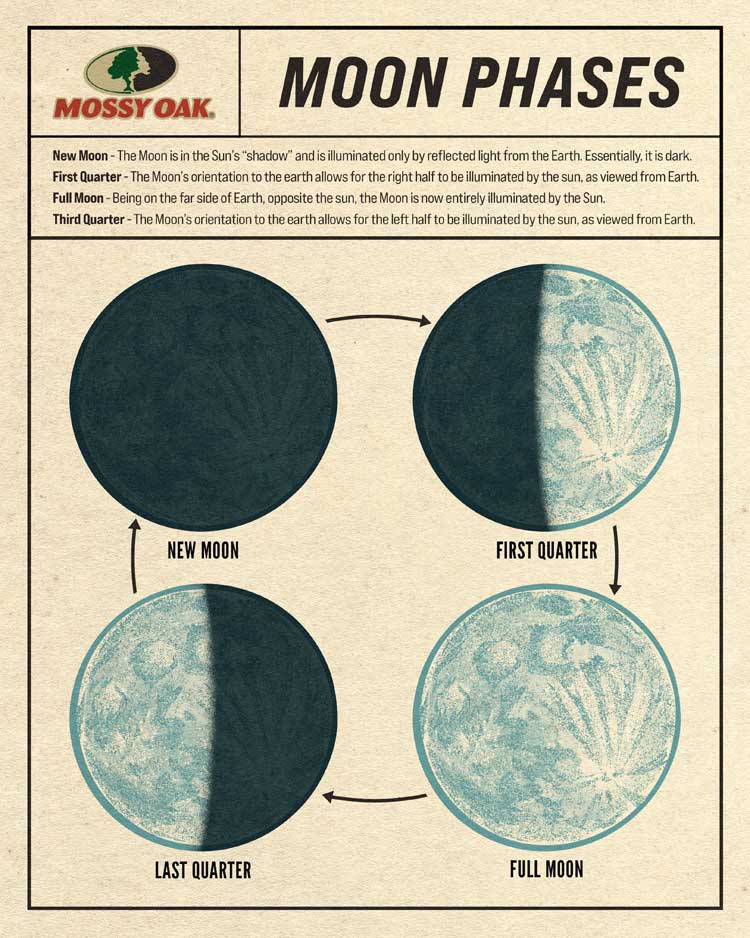
- New Moon - The Moon is in the Sun’s “shadow” and is illuminated only by reflected light from the Earth. Essentially, it is dark.
- First Quarter - The Moon’s orientation to the earth allows for the right half to be illuminated by the sun, as viewed from Earth.
- Full Moon - Being on the far side of Earth, opposite the sun, the Moon is now entirely illuminated by the Sun.
- Third Quarter - The Moon’s orientation to the earth allows for the left half to be illuminated by the sun, as viewed from Earth.
The quarters can further be divided based on the shape of the illuminated portion of the moon and its phase. Between the New and First Quarter phases, when the Moon is illuminated between 1 and 50 percent, it is called a waxing (growing) crescent. Between the First Quarter and Full (50-100 percent) it’s called a waxing gibbous. From full Moon to Third Quarter (100-50 percent illumination) it is a waning (shrinking) gibbous. And finally, from Third Quarter to New it is a waxing crescent.
Fun Fact: Sci-Fi fans might appreciate this. The boundary line or transition between the illuminated and dark portions of the Moon is called a lunar terminator or twilight zone.
Effects of Moon Phase
Most people don’t realize just how much the moon affects our daily lives. For example, the gravitational pull of the moon is responsible for the daily ebb and flow of ocean tides as it orbits around the earth. In addition to position, moon phase also influences tides. When the moon is full or new, the Earth, sun and the moon are lined up, and the combined gravitational force of the moon and sun create higher high tides and lower low tides, a phenomenon known as a spring tide. During quarter phases, when the gravitational forces of the moon and the sun are perpendicular to one another with respect to the Earth, there is less tidal variation and we experience neap tides.
As most animals are made up of somewhere between 50 and 75 percent water, you might expect that the moon would influence animal behavior. There are numerous reports on how the lunar cycle impacts human reproduction, admittance to hospitals and emergency units, traffic accidents, crimes and suicides, not to mention general behavior at facilities for the mentally infirm. Unfortunately, most of the hard research finds no correlation. Just the same, I never seem to sleep as well during the full moon.
There is evidence that the lunar cycle influences some animals. Migrations and reproduction of some fish species have been tied to the lunar clock, and sea turtles are said to time their egg laying around the full moon. There’s also evidence that the lunar cycle exerts its influence on laboratory rats and mice and some insects. Virtually all marine animals are influenced by the tides, and since the tides are controlled by the moon, I suppose you could say their behavior is affected by the moon as well.
Similarly, most animal behavior is influenced by photoperiodism, changes in the amount of daylight. As the amount of sunlight being reflected off the moon and to the earth varies with lunar cycle, you would expect that might also play a similar, albeit less important part. In their book “Solving the Mystery of Deer Movements,” authors Dr. James Kroll and Ben Koerth wrote:
"Because the moon is such a noticeable phenomenon in our world... it seems almost intuitive it must have equally profound effects on the habits and lifestyles of animals as well, at least we all want to believe it to be so."
Indeed.
Does Moon Phase Affect Deer Movement?
There have been several theories proposed about how the moon affects deer movement. One revolves around moon position and suggests deer movement increases when the moon is directly overhead or underneath. These two periods, each of which occurs once each day, are termed major and minor peaks, respectively. And I know several hunters who strongly believe in it. Unfortunately, there’s not a shred of scientific evidence to support the notion. None.
Another theory offers that during the full moon, deer move more at night and less during the day. While it’s not pronounced, my personal observation from over 40 years of whitetail hunting and study has been that daytime deer activity does seem to decline during the full moon. To be more precise, I see less movement during typical peak periods of dawn and dusk. And while very subtle, I have also observed a slight increase in mid-day movement.
One of the more comprehensive research projects on the subject was conducted by Dr. Mickey Hellickson, former chief wildlife biologist at the King Ranch in South Texas. Hellickson used GPS-based transmitters and activity monitors to track the movements of collared deer from 6 a.m. - 7 p.m., from October through January over a two-year period, collecting more than 420,000 observations from 43 collared bucks. Results showed daily buck movements peaking at 7 - 9 a.m., 6 - 7 p.m. with a slight peak at midnight. Lowest hourly movements occurred from 5 - 6 a.m., 3 - 4 p.m. and 10 - 11 p.m. More importantly, this pattern was relatively consistent throughout the four-month range, regardless of moon phase, though overall movement increased during peak rut times.
Hellickson concluded: "Although the moon may influence buck movements in other ways, our data did not indicate any patterns relative to the effects of moon phase on buck movements."
However, summarizing their results from a trail-camera study, fellow Texans Kroll and Koerth found, "The lowest amount of daytime activity occurs during the full moon, while the new moon has the greatest amount of daytime feeding."
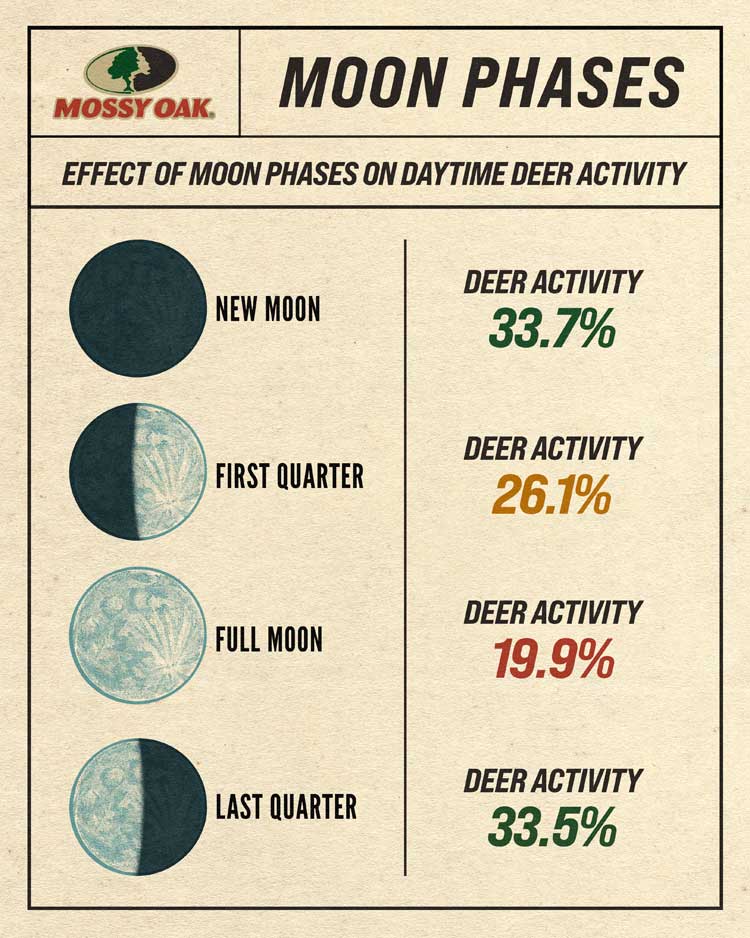
One of the few recent studies on the subject was conducted by Marcus Lashley while doing graduate work at North Carolina State University. Comparing results from over 22,000 GPS fixes to moon phases, he found that deer movements are largely crepuscular (active during twilight), regardless of moon phase or position. He further determined that solunar predictions were not significant and only accurate about 25 percent of the time, within a three-hour window, from both a statistical and practical standpoint. However, he also observed some minor trends that might be worth noting.
Peak movement occurred, as expected, around dusk in all phases except one. During the new moon, movement rate peaked near dawn, and lasted a little longer into the early morning. Rather than 7.4 days, Lashely divided phases into five-day windows centered on new, first quarter, full and last quarter. This left eight days, which he lumped into the non-quarter phase. And, he observed mid-morning movement rates were highest during these non-quarter periods. Though still relatively low and not statistically significant, his study also found mid-day movement tended to be greatest during the full moon. Last but not least, late afternoon activity peaked during the last quarter.
Before you go scheduling vacation days based on moon phase you should bear in mind that even Lashley’s results clearly show most deer movement occurs at dawn and dusk during every phase, and non-phase. Still, movement patterns may be ever so slightly varied during certain moon phases, all other things being equal. Unfortunately, they seldom are.
Does Moon Phase Affect the Rut?
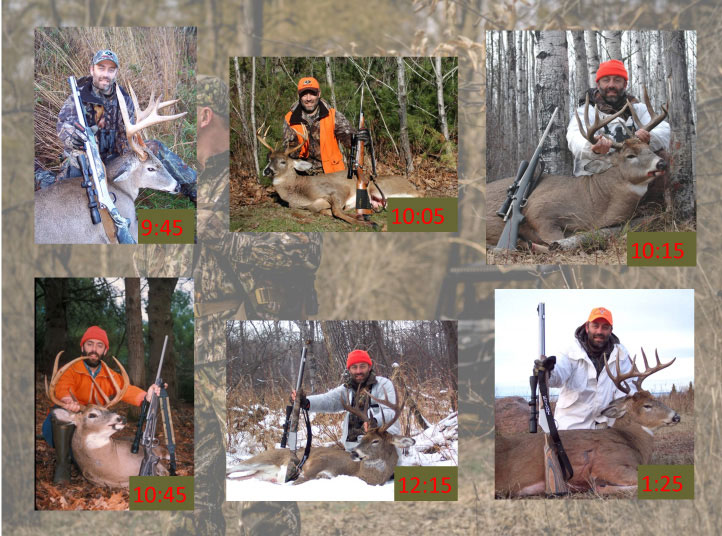
Another theory suggests that moon phase can influence timing of the rut, and therefore peak activity periods. We know the onset of breeding season is influenced primarily by photoperiodism - changes in the amount of sunlight as the days grow shorter. This causes physiological processes in deer that trigger their reproductive system.
Light is light, right? So one could easily conclude that changes in the amount of moonlight might also have an effect. And because the full moon does not occur at the same time annually, peak breeding dates would change from year to year, possibly by as much as a couple weeks. It sounds good in theory, but to date there is no peer-reviewed empirical evidence to support it.
That’s kind of a shame because a lot of work went into developing that theory, and it seemed to make sense. As a means of testing the theory, I contacted deer biologists from each of the states with whitetails to get their take.
It turns out there is variability in peak breeding dates between states. For example, peak breeding in Maine was November 17-23 while in Iowa it was November 8-15. There’s also a good deal of variability within states, particularly as you move south. North Carolina’s peak averages around November 15, but varies by region from as early as late October to late November. Peek breeding dates in Mississippi occur from early December (northwest) to late January (southeast). And by traveling around the State, you can find peek breeding somewhere in Texas from the end of September to the end of December.
However, while peek breeding dates varied, sometimes by a month or more from one geographic area to another, every state had one thing in common. For any given location, peek breeding dates occurred at the same time every year, regardless of changes in moon phase timing. In many cases this is based on decades of data.
For any given location, peek breeding dates occurred at the same time every year, regardless of changes in moon phase timing.
What is The Rut?
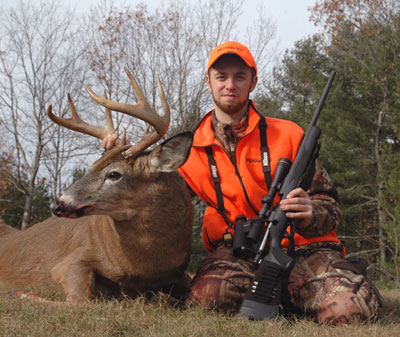
the same ladder stand, my son has taken a buck while it
was aggressively tending a doe, all between
November 15-18.
Some of the misunderstanding around moon phase and rut may have to do with terminology, and it begins at the most basic level. A lot of folks don’t fully understand what is meant by “the rut.” It is the mating period for deer, and encompasses all physiological and behavior activities associated with courtship and breeding. This includes when a buck first paws the ground to leave his scent in early Autumn, when a pair of bucks square off to determine dominance and when one of those bucks goes on walkabout searching for a potential mate.
To a hunter, peak rut is that magical time when bucks are chasing does hither and yon, and even normally super-wary mature bucks briefly drop their guard and expose themselves during daylight. To a biologist, peak rut is peak breeding, a period when the majority of older bucks and receptive does have paired up and are mating. While there may be brief bouts of activity, it can be a rather slow time that hunters sometimes refer to as the lockdown phase.
Even the term “phase” is a source of considerable misunderstanding. A prime example is that theory tying moon phase to phases of the rut. While there are distinct behaviors associated with the rut that we sometimes refer to as phases, it’s important to understand that individual deer are not synchronized in these phases. In fact, they can be quite disparate.
For example, one hunter might see bucks chasing does, and conclude the rut is on. Another might see a buck cautiously approach a nervous doe then lose interest and decide the rut is still a few days away. Yet another may spend the entire afternoon watching bucks and does casually feeding side-by-side and not know what is going on. And another still could spend a dull afternoon watching birds and squirrels and speculate it is the lock-down phase. That all sounds like what we’ve been taught by the self-proclaimed experts about rut phases.
However, it’s not at all unusual for all of the above to occur on the same piece of ground, on the same day. Rut “phases” are both local and short-lived. If a buck wakes up, leaves his bed and strikes out in search of a hot doe, he has just entered the seeking phase. The moment he finds one, he’s just entered the chasing phase. And if he catches her, they could well go into lockdown. And all this could occur within a few hours while other deer are shifting in and out of other rut phases.
Science Versus Nature
Scientists in general, and wildlife biologists in particular, are among the most meticulous and skeptical people you’ll ever meet. When it comes to something like deer behavior, you’ll be hard pressed to get them to say anything definitive without couching it with qualifying words and phrases like “probably,” “in general” and “most often observed,” unless it’s been published in a peer-reviewed scientific journal. And that doesn’t happen until their hypothesis has been tested, re-tested, picked apart by their peers and accepted. By the time it reaches the pages of a scientific journal you can be fairly certain of two things: it’s accurate and truthful.
There have been numerous efforts to tie general deer activity patterns and rutting activity to moon phase or position. Some of them were well thought out and implemented. But with little exception, there is almost no hard, scientific evidence showing a clear correlation between moon phase and deer movement. That doesn’t mean the information is worthless or entirely inaccurate.
One of the first things I was taught as a wildlife student was: “If what you observe in nature differs from the textbooks and journals, nature is right.”
The Best Time to Hunt Deer
Earlier I mentioned that Marcus Lashley’s research was able to tease out very subtle trends that might be helpful if all other things remain equal. But there is all manner of variables that can influence deer movements, like day length, wind, precipitation, temperature, barometric pressure and most certainly, hunting pressure. We could easily devote as much space to any one of those as we have allowed above for talking about the moon (and perhaps we will.) So we’re left with studying the trends and playing percentages in hopes it may give us the slightest of edges. And as my friend Mike likes to say, “The best days to be in the woods are when the hunting season is open.”
